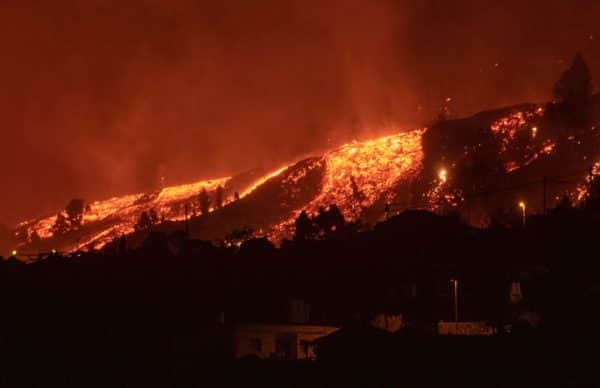Volcano erupts on Spanish Canary Island of La Palma - here’s the latest travel advice
and live on Freeview channel 276
A major volcanic eruption is threatening homes on the Canary Island of La Palma, a popular destination for sun seeking tourists.
At around 15:15 local time on Sunday, 19 September, a week-long increase in seismic activity culminated in spectacular lava flows emanating from the Cumbre Vieja volcanic ridge near the southern end of the island.
Advertisement
Hide AdAdvertisement
Hide AdAround 5,000 people have been evacuated from their homes as lava streams poured down the mountainside; at least eight houses have been lost to the bright red rivers of molten rock.
Mariano Hernández, president of La Palma island, said there were no immediate reports of deaths or injuries but the lava flows made him concerned “about the populated areas on the coast.”
“People should not come near the eruption site where the lava is flowing,” he said. “We are having serious problems with the evacuation because the roads are jammed with people who are trying to get close enough to see it.”
Here is everything you need to know about it.
Where is La Palma?
La Palma is the most north-westerly of the Canary Islands, located in the Atlantic Ocean off the north-west coast of Africa and Morocco.
Advertisement
Hide AdAdvertisement
Hide AdLa Palma is the fifth largest of the eight main Canary Islands, and has a population of around 85,000 people.
Like all of the Canary Islands, La Palma originally formed through submarine volcanic activity, and is currently, along with Tenerife, the most volcanically active of the islands.
What happened?
A 4.2-magnitude earthquake was recorded just before the eruption, which destroyed at least eight homes in the village of El Paso.
Hundreds of people in immediate danger were evacuated, roads were closed and authorities urged the curious not to approach the area.
Advertisement
Hide AdAdvertisement
Hide AdAuthorities have warned that the lava flows could also threaten the municipalities of El Paraíso, Alcalá and surrounding areas.


Carlota Martín was at an agricultural plot her family has just downhill from the eruption site, when she heard a huge explosion.
“When we saw the column of smoke, we thought it could not be real, but it kept growing and we knew we had to get out of there,” she told Associated Press.
“You leave, but you are also looking back because you want to see what will happen. Nobody knows how the lava flows will descend, but our plot and lots of houses in the area could be in the way.”
Advertisement
Hide AdAdvertisement
Hide AdSpanish Prime Minister Pedro Sánchez, who cancelled his trip to New York to attend the UN General Assembly so he could travel to the Canary Islands, said the people of La Palma should “rest assured that we have all the resources and emergency personnel necessary.”
Is it safe to travel there?
The Foreign Office’s travel advice to the island encourages travellers due to visit the island “imminently” to contact their tour operators or airlines.
“If you are in an affected area,” it says, “you should follow the advice of local authorities, including social media updates from Cabildo de La Palma.”
It is the first volcanic eruption seen on the island since 1971, an event which saw volcanic activity continue for over three weeks; Spain’s National Geology Institute has said it is too early to tell how long this eruption will last.
Will it affect flights from Liverpool John Lennon airport?
Advertisement
Hide AdAdvertisement
Hide AdAt present the airport’s routes to nearby Canary islands Fuerteventura, Gran Canaria and Lanzarote are not effected, despite ash being projected into the sky above La Palma.
A spokesman for the airport said: “At this time we have just one movement to the Canaries which is on a Friday. At this time it is unaffected.”
The eruption has forced the temporary closure of the Liverpool Telescope - one of the largest robotic telescopes in the world - which is located on the island.
Dr Chris Copperwheat, Liverpool Telescope Astronomer in Charge at Liverpool John Moores University, said “We’re not using it at the moment because of the amount of ash in the atmosphere, but otherwise all is well.
Advertisement
Hide AdAdvertisement
Hide Ad“The eruption is about 16km south of the observatory. I’m not sure how long we’ll be keeping the telescope offline as a precaution, but it’s probably days rather than weeks or months.”
A version of this article originally appeared on our sister title, NationalWorld